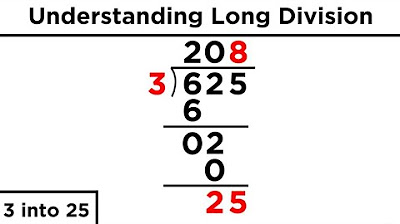Multiplication of Large Numbers
TLDRThe script outlines techniques for mentally multiplying large numbers. It first reviews the standard written algorithm before explaining how the distributive property can be leveraged to break numbers into easier factors that can be multiplied in one's head. Two examples are walked through step-by-step, first using the rigid algorithm and then using mental math tricks. The mental math strategies require less computations and lower the chance for error. Readers are challenged to practice mental multiplication as it is an invaluable life skill.
Takeaways
- 😊 We should know the standard algorithm for multiplying large numbers on paper, but mental math tricks are faster.
- 👍🏻 Breaking numbers into easier components makes mental multiplication simpler via the distributive property.
- ✏️ Write out the multiplication step-by-step if needed, but mental math is a useful life skill.
- 🧮 Know your times tables to multiply individual digits quickly.
- 🔢 Place values dictate where digits go when multiplying step-by-step.
- 🔟 Multiplying by 10 just adds a 0.
- 🤓 Applying the distributive property shows the connection between the standard algorithm and mental math.
- 🧠 Mental math introduces creativity in developing easier multiplication strategies.
- ⚠️ Writing it out opens more chances for errors.
- 🎓 Practice mental math even if you have your own method, as long as your answers are right.
Q & A
What is the first step when multiplying large numbers on paper?
-The first step is to put the larger number on top, line up the places, and multiply each digit of the top number by the rightmost digit of the bottom number.
Where do you place the first digit when multiplying numbers on paper?
-The first digit goes in the units place.
How does the distributive property help in mental multiplication?
-The distributive property allows you to break down one number into component parts that are easier to multiply mentally before summing the individual products.
What is the benefit of adding zeros when multiplying by 10 or higher powers of 10?
-Adding zeros simplifies the mental multiplication, since multiplying by 10 just shifts everything one place value to the left.
What are the two main methods of multiplication covered?
-The two main methods are the standard algorithm done with paper and pencil and mental math using the distributive property.
Which method is less prone to errors?
-Mental math using the distributive property and easier numbers is generally less prone to errors than the rigid algorithm using paper.
What is one benefit of being able to do mental math?
-Being able to do mental math quickly is a great life skill that allows you to perform calculations without relying on external tools.
What is a good way to practice mental multiplication?
-A good way to practice is to challenge yourself by not writing anything down and multiplying larger numbers in your head.
Why set up multiplication problems vertically?
-Setting up the multiplication vertically with the larger number on top keeps the place values aligned correctly for adding partial products.
What should you do if you get stuck on a mental math problem?
-If you get stuck, try breaking the numbers down into easier components using the distributive property until you reach pieces you can multiply mentally.
Outlines
😀 Learning Different Methods for Multiplication
This paragraph explains two methods for multiplying large numbers: the standard algorithm taught in schools which involves lining up the numbers and multiplying digit-by-digit, and a faster 'shortcut' method using the distributive property to break numbers into easier parts before multiplying.
😃 Practicing Mental Math for Life Skills
This paragraph encourages practicing mental math as an important life skill, challenging the reader to try multiplying numbers without writing anything down to check comprehension.
Mindmap
Keywords
💡multiplication
💡times tables
💡algorithm
💡distributive property
💡mental math
💡rounding
💡computation
💡strategy
💡error
💡comprehension
Highlights
We know what multiplication is, and hopefully we memorized our times tables.
Well let’s first learn how to do this rigorously on paper, but then let’s learn some easy tricks that will help us do this in our heads much more efficiently.
The distributive property tells us that this is the same as fourteen times ten plus fourteen times one, and these products are easy to get in our heads.
Really, these two methods are doing exactly the same thing, it’s just that one follows a rigid algorithm, while the other involves a little more creativity,
Let’s try another one, four hundred twenty-five times twelve.
If you like using pen and paper and are very diligent, there is no problem with this approach, but it opens up a lot of opportunities for error,
Instead of four hundred twenty-five times twelve, let’s do four hundred twenty-five times ten plus two.
When multiplying by ten we just add a zero, so that’s four thousand two hundred and fifty.
Add them together, and we get our answer.
Let’s take a moment to notice that these numbers are the same as the ones we added together when using the other approach.
When we multiply through the units place, we are multiplying by two. When we multiply through the tens place, we are multiplying by ten.
But while the first method requires many small computations, the second method requires comparatively fewer.
Still, through practice, you may find your own method that works for you,
Being able to do mental math is a great life skill to have,
try not to write anything down, and let’s check comprehension.
Transcripts
Browse More Related Video

The Distributive Property for Arithmetic

Mental Math Tricks - Addition, Subtraction, Multiplication & Division!

Division of Large Numbers: Long Division

How to EASILY Improve Your Mental Maths | 8 Simple Tricks

Matrix Multiplication and Associated Properties

5 Simple Math Tricks For Fast Calculations | Mathematics Tricks for Daily Use | ChetChat Math Tips
5.0 / 5 (0 votes)
Thanks for rating: